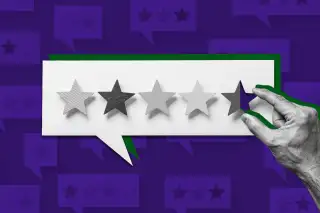Shopping Online? The Product Ratings Are (Probably) Fooling You

Looks can be deceiving, and that’s especially true with those ubiquitous ratings that accompany countless products online and in stores.
The five-star rating system, for instance, is commonplace on Google and Amazon. Millions of shoppers rely on it every day to help them decide what to buy, and where. However, just-released research shows that the way the ratings are displayed — whether as a star or a numeral — can make a huge difference in how people interpret them.
According to a new study from Cornell University, it all boils down to how our brains process visual stars versus numbers. Take a rating of 3.5, for example. In star form? Shoppers are far more likely to interpret it as four stars than its true rating.
“Where there are three full stars and one half star — our brain automatically completes this half picture,” Deepak Sirwani, a marketing professor and co-author of the study, said in a news release. The marketing researchers referred to this as the “visual-completion effect.”
At the same time, the opposite is true for numerals. We tend to round them down due to a so-called “left-digit effect.”
“When the same rating is communicated using numbers, we focus on the left digit,” Sirwani said. “That’s why 3.5 feels more like a 3 than a 4.”
The study, which published Thursday in the Journal of Marketing Research, included six experiments that gauged how people interpret, communicate and remember different displayed ratings, as well as whether the type of rating increase the likelihood of the person’s willingness to buy an item. The researchers tested both star shapes and circles.
In general, people overestimated visual ratings — aka ones with star icons — regardless of whether they ended in 0.25, 0.5 or 0.75. Across the board, visual ratings led to test shoppers being more willing to buy an item.
Tips for checking reviews and ratings
The Cornell study is mostly good news for businesses. For shoppers, not so much.
Visual ratings often lead you to inflate a product’s true rating in your mind, which could translate into you shelling out money on something that doesn’t meet your expectations. (We’ve all been there.)
Because of this phenomenon, you should pay careful attention to the format of ratings. Are they numbers, stars or some other shape? Maybe some combination of them? Try your best to verify the true numerical rating, if available, instead of inferring it from stars or other icons.
Once you’ve found that out, it’s worth it to dig a little deeper. Fake reviews have proliferated online, but a few quick steps can help you determine fact from fiction.
- Determine the number of ratings. The more ratings, the better. Most of the time, a 4.5 rating for a product that was reviewed thousands of times is better than a 4.5 rating for something rated by only a couple people. That's because small sample sizes can skew results and make it hard to determine trends.
- Scan the wording. Skimming through the written reviews can be helpful. You might get some genuine tips from other buyers. You may also come across reviews that are copied and pasted (or use extremely similar language), which can indicate the seller is trying to game the system. Sometimes sellers pull a bait-and-switch, where they collect genuine reviews for a product but then change the listing to a completely different, usually more expensive, item. The item then appears like it’s been reviewed 200 times, but in reality, the reviews may be for a pair of socks — not the microwave you’re looking to buy.
- Check the review dates. The published dates (if visible) can give you an idea if the product was rated organically or if there was an organized push to flood it with ratings. Let's say you are looking into a product with 50 reviews, but dozens are posted on the same day. That’s a solid indication of fake reviews.
- Try a review scanner. Given how popular fake reviews are, new tools are cropping up to detect them by automating some of the tips above for you. One free example is Fakespot by Mozilla. It's not perfect, but it analyzes the URL of product- and business-rating pages for fake reviews, giving them an A to F letter grade in a matter of seconds.
No one method is foolproof, and, yes, some can take a little bit of time and digital sleuthing. Still, incorporating one or more of them into your shopping routine can help you accurately interpret ratings — and avoid scams.
More from Money:
GOP Tax Bill Would Extend Trump's Tax Cuts, Create 'MAGA' Accounts for Kids and More
Ticketmaster and StubHub Must Now Display Upfront Prices for Concert Tickets
How I Bought a Home With Zero Down Payment and Scored a 4.75% Rate